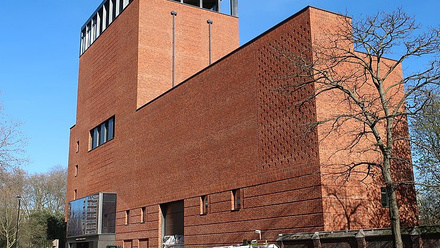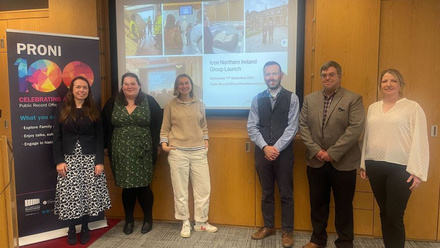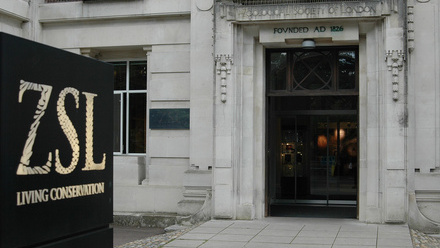My Museum of Plastics: Having a Breakdown
People collect and are enthused by plastic objects for many reasons but for us, one of the things which fascinates the most, is how plastics degrade and breakdown. We have found ourselves collecting items which show varying signs of breakdown and watch avidly to see how it might progress. It can be quite difficult to find plastics in perilous condition, often they have already been thrown away but we like to rescue them from the bin and give them a whole new lease of, if not life, then decay.
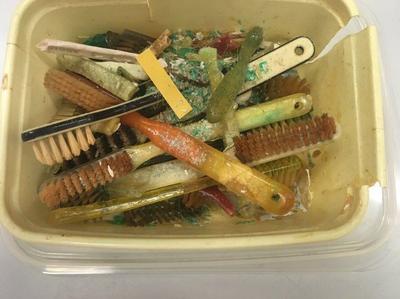
Ten years ago I was given a collection of already very degraded toothbrushes by someone who knew that I liked “bin fodder”. A real mish-mash of colours and styles mainly made by The Addis Company in the early – mid twentieth century. This particularly interested me as the invention of the mass produced toothbrush, made then from animal bone and bristles, has been credited to William Addis in 1780 and living in Hertford for many years I was very familiar with the striking 1935 design of the Addis factory building. Whilst these toothbrushes are not currently at home with me during the current lockdown and using the images here, which were taken on my phone around two years ago, I thought I’d pull together what I know about them and how they are breaking down over time.
What I have found out is that Celluloid toothbrushes possibly appeared in Woolworth’s as early as 1908 still using animal bristles in the head, but in the 1940’s nylon bristles were produced. The toothbrushes in the images here appear to be mainly nylon bristled, so 1940’s and later presumably, but there is a large headed one with black and white bristles which looks more likely to have animal bristles so could be earlier than the 1940’s. When I first brought them home, they were mainly structurally intact but showing variously sweating, discolouration, crazing and collectively smelling very acrid. I used an empty ice cream carton, possibly polystyrene, for storing the toothbrushes, having removed them from their bag. At that point the carton had a lid, so I sealed the toothbrushes in the carton and left it on a shelf in my garage for around 2 – 3 weeks. I then picked it up to move it only to find it was sticking slightly to the shelf. When I turned it over there were already several small holes in the base. I peeled the lid off and the smell was overpowering. Most of the plastics were covered in a greasy film, small pieces had become detached from some brushes, colours and opacity of the handles were changing and some were showing crazing and cracking. Over the following months, the holes in the container grew worse and the lid cracked, becoming so fragile it broke up and the acrid smell was so strong I had to seal everything in a polythene bag. The carton started to crack and yellowed in colour from the original pristine white and this can clearly be seen in the images.
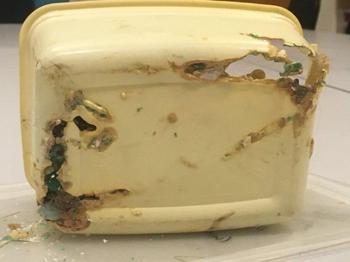
Several years ago I had the chance to have them analysed when my manger took them to an event where they were able to establish what plastics were present. He returned with the information that the carton included cellulose acetate (CA), cellulose nitrate (CN) and casein plastics, but that was all the information I had. I have since also placed an AD-strip in the box, which turned yellow almost immediately (seen in the images here) indicating a very acidic environment. The problem was that the plastics by this time had started to stick together as their surfaces became disrupted and sticky and were contaminated with multiple pieces detached from other toothbrushes. However, it was thought that possibly the pink toothbrush was Casein.
For me, with this collection of toothbrushes, it’s not necessarily about knowing the actual plastics from which they are constructed. My fascination is with the rapidity of the breakdown and how aggressively the by-products have attacked the storage container and the toothbrushes themselves. It is with the fact that these individual objects have started to join and melt together, to become part of new composite pieces of plastic, becoming inextricably stuck together as they decay. It is with seeing how they are disintegrating and changing over time and how this can be seen, felt and smelt. I have had these toothbrushes for around 10 years now and I don’t know how much longer it will be until they become mere dust and their container is eroded away by their acidic by-products. These objects have / will soon cease to be toothbrushes by definition and will become something else. For some people they would have ceased to be of use or beauty, not in “good” condition, or to be collected, admired and have aesthetic value or usefulness attributed to them and in most eyes are only fit for the bin. But to me they are akin to a “living” object in its death throws and it is both beautiful and awesome to behold.
I was recently sorting through a very untidy box of old chargers, adapters and obsolete electronic devices that have amassed over the years, the perfect stay-at-home task! As well as being reminded of how big iPods and SIM cards used to be, and finally finding that electric toothbrush charger missing since 2018, I was very interested to discover a couple of degraded plastic mobile phone chargers. Tangled in a ball of cables in otherwise good condition, one of the chargers appeared distinctly yellow and brittle with a noticeable rubbery smell, the other extremely sticky and covered in a layer of well-adhered dust. It instantly got me thinking about what plastic(s) I could be looking at, and once again fascinated by the varied, seemingly spontaneous and bold ways in which plastic materials remind us of their complexity and vulnerability.
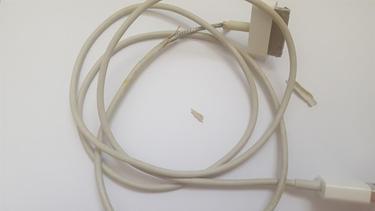
It’s well known that vulcanised rubber was one of the earliest cable insulation materials widely used for domestic applications. In the first half of the twentieth century plasticised polyvinyl chloride (PVC) and polyethylene (PE) provided alternatives, but the superior abrasion and weathering resistance properties of rubber have ensured its continued application in particularly challenging environments, such as, cables for power tools, pumps and generators. Many more plastics are now available for the insulation and sheathing of electrical and mains power cables, and many boast very specialist and desirable properties. Incredibly hardwearing thermoset plastics such as chlorosulfonated polyethylene (CSPE) have been adopted for use in industry due to their ability to withstand high temperatures, high voltages and significant physical force. Polychloroprene (PCP), a type of synthetic rubber, is used for cabling in exposed outdoor environments due to its impressive ability to withstand weathering.
Highly specialised formulations aside, due to their versatility and ease of manufacture, it’s PVC and PE that seem to be used for the construction of many of the electrical cables that we come across in our everyday lives. Of these two plastics, I think it’s likely that the black phone charger cable is made from PVC due to its sticky, oily coating- a well documented symptom of the migration of phthalate plasticisers, frequently used in the manufacture of plasticised PVC formulations.
The 10-year-old iPhone charger however is unlikely to be plasticised PVC due to Apple’s well publicised commitment to cease use of PVC and phthalates in the manufacture of its products from around 2010. Apple’s 2016 Environmental Responsibility Report broadly states that PVC and phthalates are replaced with ‘thermoplastic elastomers’…which could go some way to explaining the smell?! And as is the case for all plastic materials, it’s likely that many complex interactions are responsible for the other observed changes to this cable’s colour and flexibility. Like The Addis Company toothbrushes, it would be all too easy to label these phone chargers as useless, disfigured and fit for the bin, maybe even more so as they are so easy to replace.
In 2014 I remember reading Preserving Plastics- An Evolving Material, a Maturing Profession by Odile Madden and Tom Learner. At the time I felt both inspired and reassured, and one section in particular has continued to resonate:
“If we become more willing to make tough decisions about objects that just will not survive, resources can be reallocated for investigation and documentation of the technologies these objects represent and of their paths to failure.
Compiling these histories, tracking stability, and figuring out causes of and remedies for change are valuable contributions that our profession can make to the Plastic Age.”
So, far from being an ice cream tub full of fragmented toothbrushes and a pair of redundant phone chargers, these objects take on a new value. Their paths to failure are a rich resource, telling us about the early experimentation of mass produced semi-synthetic formulations, and of a time where social and environmental pressures were so great, technology giants had no choice but to innovate and brand new and ‘more responsible’ materials.
We don’t have to hang on to every piece of degraded plastic we come across, (Libby and I will give it a good go!) but we should strive to observe, track, document, question, and value degradation, and what it can teach us.



